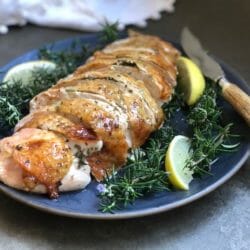A lot of anxiety seems to swirl around the task of cooking a turkey. Consider the fact that an entire hotline is devoted to turkey. The fact that it’s called “The Turkey Talkline” speaks volumes about the seriousness of the matter. But here’s the thing: a turkey is really just a great big chicken. So if you’ve ever cooked a chicken, you’ll be capable of doing a turkey as well. That said, you can make it one notch easier for yourself by skipping the whole bird altogether and just do a roasted bone-in turkey breast.
Why a Roasted Bone-In Turkey Breast?
Even though I’m a girl who appreciates a turkey leg or thigh, there are some serious upsides to cooking the breast alone. First off, if you don’t have a crowd big enough to take down a whole bird, the breast is a good bet. Also, when you cook a whole turkey, the legs need to cook longer than the breast, which is why overcooked turkey seems to be the Thanksgiving norm. If you stick just with the breast, you avoid that conundrum altogether. My personal preference is a bone-in versus a boneless breast, since that bone imparts flavor and leaves you something with which to make turkey broth the next day.
Dry Brine That Bird
If you have the time, I recommend you dry brine your turkey before cooking it. That basically means generously salting the whole thing and leaving it exposed in the fridge for one to three days before it goes into the oven. The salt flavors and tenderizes the meat and refrigeration dries out the skin, making it extra crispy when roasted.
Bone-In Turkey Cooking Time
Overcooked turkey seems to be an epidemic. Most recipes advise taking turkey breast to a temperature of 165 degrees fahrenheit as recommended by the USDA. The problem is, the internal temperature continues to rise even after the turkey is out of the oven. By the time you serve it, it’s probably overcooked. For me, pulling the turkey breast at 150 degrees is the sweet spot…a bird that is plenty juicy and will reach a safe temperature by the time you serve it. Cooking time will vary depending on the size of the breast, but figure roughly 1 ½ to 2 ½ hours.
Give it a Rest
Key for a tender turkey breast is letting it rest a good 20 to 30 minutes after it’s out of the oven. Cover it loosely with foil and set it in a warm spot until you’re ready to carve. That will help the juices stay in the bird and not rush onto your plate with the first slice of your knife.
Carving your Turkey Breast
Carving a turkey breast is no different from carving the breast from a whole chicken. There are two half breasts connected by a center bone. Run a knife down the center along the bone to free one breast half. Repeat with the second breast half. Then, lay the breast halves on a cutting board and cut against the grain into slices. Arrange on a platter and spoon the delicious juices that have pooled over the top of the meat.
For tasty sides for roasted bone-in turkey breast, check out:
Arugula, Delicata Squash, Pomegranate Salad
Olive Oil Mashed Cauliflower & Potatoes

Whole Roasted Bone-In Turkey Breast
If you’re serving a smaller crowd or just prefer the white meat of a turkey, this recipe is a good bet. Dry brining the turkey in advance and smothering it in a garlicky herb mixture will give it a tasty pop of flavor.
Ingredients
- One 4-6 pound bone-in turkey breast
- 4 teaspoons kosher salt divided
- 2 large finely chopped garlic cloves
- 1 tablespoon finely chopped fresh parsley
- 2 teaspoons finely chopped fresh thyme
- 2 teaspoons finely chopped fresh rosemary
- ½ teaspoon freshly ground black pepper
- Zest and juice of ½ lemon
- 1 1/2 tablespoons extra-virgin olive oil
- ¾ cup white wine or chicken broth
Instructions
-
Put the turkey breast side up on a roasting rack set in a roasting pan. Pat the turkey dry with paper towels. Loosen the skin over the breast with your hands and rub 1 tsp. kosher salt between the flesh and skin of the turkey. Sprinkle 2 tsp. salt over the entire outside surface of the turkey. Lightly cover with parchment paper and store in the fridge for 24 to 48 hours.
-
Remove turkey from the fridge 30 minutes before roasting. Preheat oven to 325 degrees F.
-
In a small bowl, stir together the remaining teaspoon kosher salt, garlic, parsley, thyme, rosemary, pepper, lemon zest and juice, and olive oil. Rub half the mixture beneath the skin of the turkey and the remainder on the surface of the skin.
-
Pour the wine or broth in the roasting pan and roast the turkey until golden, basting it a few times while it cooks. It’s done when an instant read thermometer registers 150 degrees (see note). Be sure to check it in a few places. Cooking time will vary depending on the size of the breast, but figure roughly 1 ½ to 2 ½ hours.
-
Remove turkey from the oven, cover lightly with foil, and let rest for 20 to 30 minutes. The internal temperature will continue to rise as it rests.
-
To carve the turkey, cut each breast half off the center bone. Lay on a cutting board and slice across the grain. Serve with pan juices.
Recipe Notes
I’ve found 150 degrees F to be a good temperature for turkey breast. However, it’s worth noting that the USDA recommends cooking turkey to a temperature of 165 degrees F.
Recipe inspired by this one on Simply Recipes and this Ina Garten recipe.